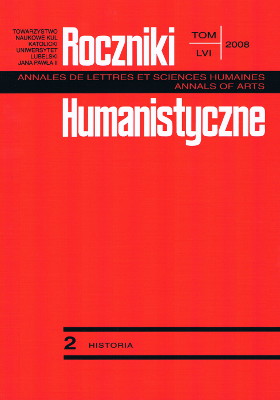Rozwój sieci parafialnej i początki organizacji dekanalnej w diecezji krakowskiej do końca XII wieku. Próba podsumowania
Abstrakt
The paper seeks to sum up the hitherto studies on the development of a parochial network and the deanery organisation in the Krakow diocese until the end of the twelfth century. The historians and the historians of the Church that deal with these problems at the 1990s formulated a hypothesis concerning the establishment of deaneries and the number of temples in the Krakow diocese before 1200. The paper combines the above hypothesis with the historians’ theses. They have recently either indirectly or directly spoken about the development of the territorial organisation of the Krakow diocese until the end of the twelfth century. The paper submits their conclusions to a critical analysis. Its conclusion is that indeed the hypothesis of the deanery network in the Krakow diocese was a one-time action. Its author was most obviously Bishop Gedko in the 1170s and the fact that there were over 1200 temples in the territory of the Krakow diocese.
Bibliografia
Chachaj J., Pierwotna średniowieczna sieć dekanalna w diecezji krakowskiej, ABMK 71(1999), s. 379-387.
Chachaj J., Powstanie dekanatów w archidiakonacie krakowskim, „Rocznik Muzeum w Gliwicach” 11/12(1997), s. 9-20.
Dobosz J., Działalność fundacyjna Kazimierza Sprawiedliwego, Poznań 1995.
Kumor B. S., Dzieje diecezji krakowskiej do roku 1795, t. I-IV, Kraków 1998-2002.
La1ik T., Zawichost we wczesnym średniowieczu, w: Szkice zawichojskie, red. T. Dunin-Wąsowicz, S. Tabaczyński, Zawichost 1999, s. 39-55.
Niewiński A., Przestrzeń kościelna w topografii średniowiecznego Krakowa. Próba syntezy, Lublin 2004.
Rajman J., Pogranicze śląsko-małopolskie w średniowieczu, Kraków 1998. Wiśniowski E., Parafie w średniowiecznej Polsce. Struktura i funkcje społeczne, Lublin 2004.
Copyright (c) 2008 Roczniki Humanistyczne

Utwór dostępny jest na licencji Creative Commons Uznanie autorstwa – Użycie niekomercyjne – Bez utworów zależnych 4.0 Międzynarodowe.





